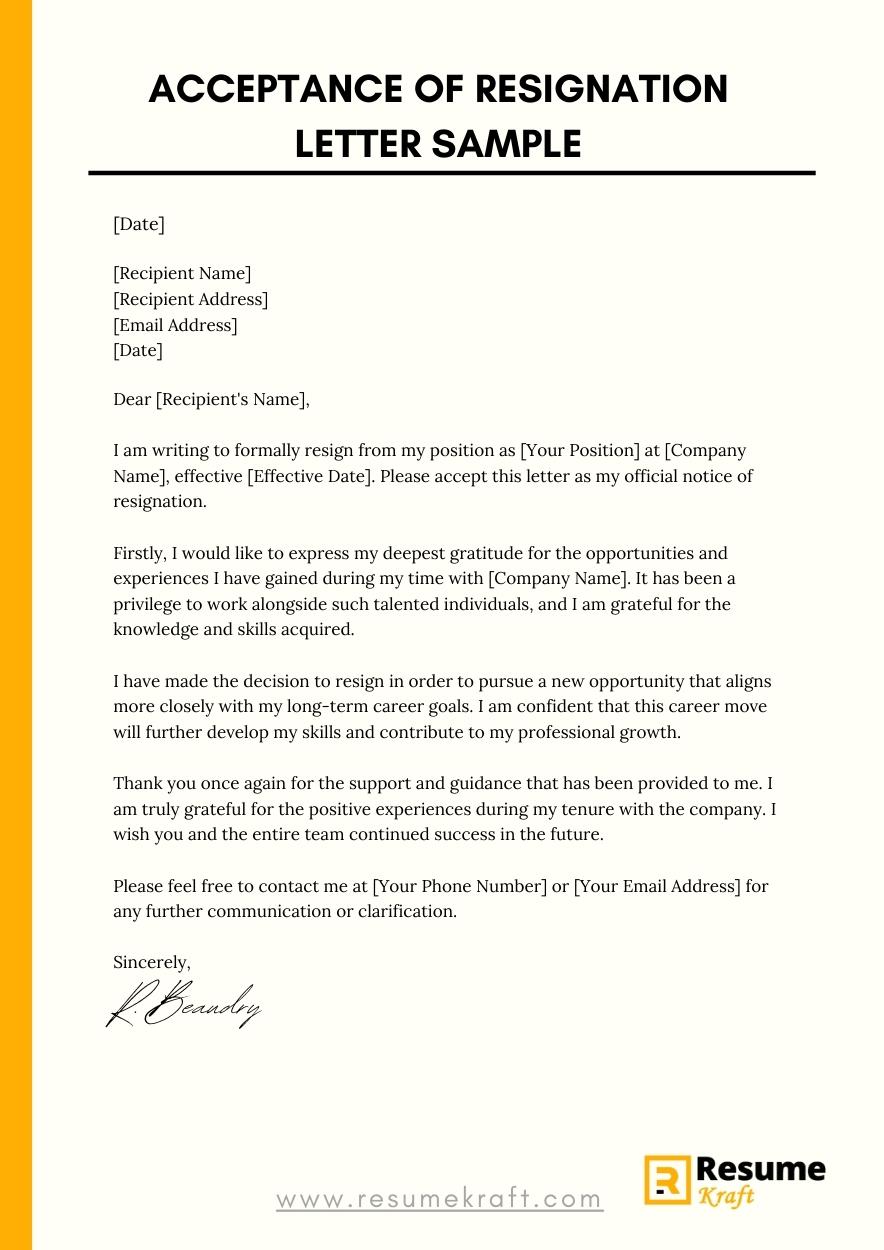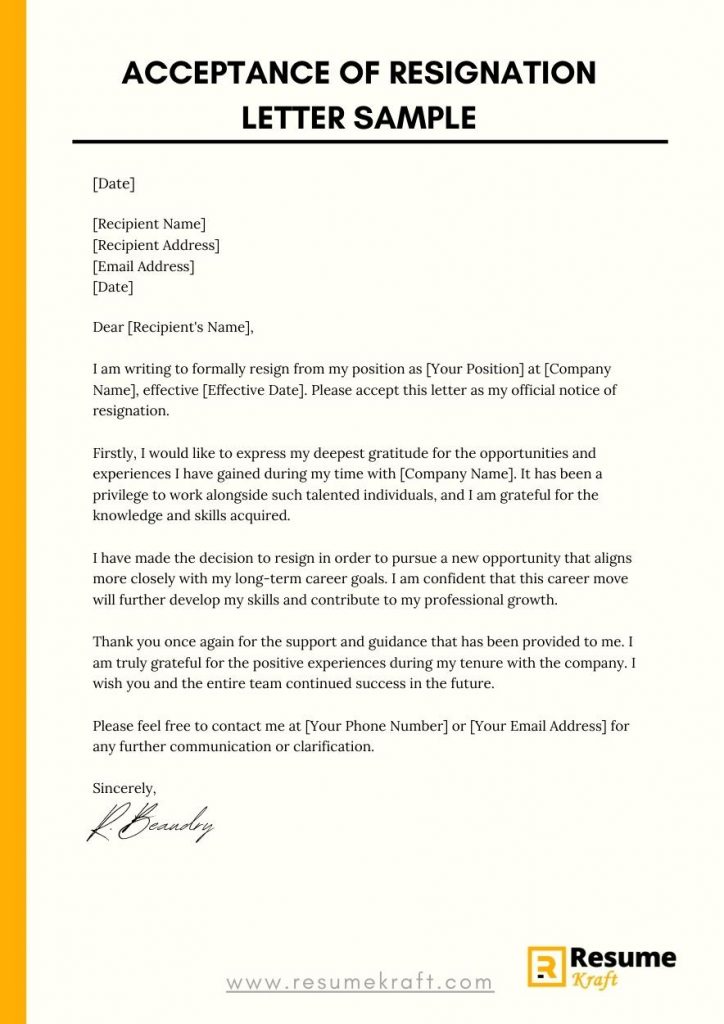
Are you considering resigning from your current job? Writing a voluntary resignation letter is an essential step in professionally communicating your decision to your employer. This comprehensive guide will walk you through the process of crafting a compelling voluntary resignation letter that leaves a positive impression. From what to include and what to avoid, to formatting tips and downloadable samples, we have you covered.
In this ultimate guide, you’ll learn how to write an impactful voluntary resignation letter that reflects your professionalism and helps maintain positive relationships. Ensure a smooth transition as you move on to new opportunities with confidence.
What To Include in a Voluntary Resignation Letter
When writing a voluntary resignation letter, it’s important to include key information that communicates your intentions clearly and professionally. Here are the essential elements to include:
- Salutation: Start your letter with a polite salutation, addressing your immediate supervisor or the appropriate person.
- Statement of resignation: Clearly state your intention to resign from your current position and provide the effective date of your departure.
- Gratitude: Express your appreciation for the opportunities, experiences, and growth you’ve gained during your time with the company.
- Reason for resigning (optional): If you feel comfortable, you can briefly mention your reason for leaving, although it is not mandatory.
- Transition support: Offer to assist in the smooth transition process, such as training a replacement or organizing your workload.
- Contact information: Provide your personal contact information for future correspondence and ensure your employer knows how to reach you after your departure.
- Closing: End your letter on a positive note, expressing well wishes for the company’s continued success.
What Not to Include in Your Voluntary Resignation Letter
While it’s important to communicate your intentions and appreciation, there are certain things you should avoid including in your voluntary resignation letter. Here’s what to exclude:
- Negative comments: Refrain from including negative remarks about your colleagues, supervisors, or the company itself. Maintain professionalism throughout your letter.
- Excessive detail: Keep your resignation letter concise and to the point. Avoid sharing unnecessary personal or professional details that may overshadow the main purpose of the letter.
- Resignation letter as a bargaining tool: Avoid using your resignation letter as a means to negotiate better terms or salary. It’s best to handle such negotiations separately and in person.
- Emotional content: While it’s natural to have mixed emotions when resigning, avoid letting strong emotions seep into your resignation letter. Maintain a calm and professional tone throughout.
How To Format a Voluntary Resignation Letter
Formatting your voluntary resignation letter properly is essential to convey professionalism and clarity. Keep these formatting tips in mind:
- Use a business letter format: Begin with your contact information, followed by the date, the recipient’s contact information, a formal salutation, the body of the letter, and a professional closing.
- Keep it concise: A resignation letter should typically be kept to one page. Use a clear and concise writing style to express your thoughts effectively.
- Use a professional tone: Maintain a business-like tone throughout your letter. Avoid using informal language or slang.
- Proofread and edit: Double-check your resignation letter for any grammatical errors or typos. Ensure the content flows well and is easy to understand.
Voluntary Resignation Letter Samples
To assist you further, here are two examples of a voluntary resignation letter – one in printed format and the other in email format.

Printed Resignation Letter Sample:
[Insert Your Name]
[Your Position]
[Company Name]
[Company Address]
[City, State, ZIP]
[Date]
[Supervisor’s Name]
[Supervisor’s Position]
[Company Name]
[Company Address]
[City, State, ZIP]
Dear [Supervisor’s Name],
I am writing to formally resign from my position as [Your Position] at [Company Name], effective [Effective Date]. Please accept this letter as my official notice of resignation.
Firstly, I would like to express my deepest gratitude for the opportunities and experiences I have gained during my time with [Company Name]. It has been a privilege to work alongside such talented individuals, and I am grateful for the knowledge and skills acquired.
I have made the decision to resign in order to pursue a new opportunity that aligns more closely with my long-term career goals. I am confident that this career move will further develop my skills and contribute to my professional growth.
To ensure a smooth transition, I am more than willing to assist in the training and knowledge transfer necessary for my replacement. Please let me know how I can be of help during this process.
Thank you once again for the support and guidance that has been provided to me. I am truly grateful for the positive experiences during my tenure with the company. I wish you and the entire team continued success in the future.
Please feel free to contact me at [Your Phone Number] or [Your Email Address] for any further communication or clarification.
Sincerely,
[Your Name]
Email Resignation Letter Example:
Dear [Supervisor’s Name],
I hope this email finds you well. I am writing to inform you that I have made the difficult decision to resign from my position as [Your Position] at [Company Name], effective [Effective Date].
I wanted to express my sincere appreciation for the opportunities and support you have provided me. It has been an incredible experience working with such a dedicated and talented team. I am truly grateful for the knowledge and skills I have gained during my time here.
I am committed to ensuring a smooth transition, and I am more than willing to support in any way possible. Please let me know how I can assist, whether it’s training a replacement or organizing my workload before my departure.
Please find my personal contact details below for any future correspondence:
Phone: [Your Phone Number]
Email: [Your Email Address]
Thank you once again for everything. I wish the company continued success and growth.
Sincerely,
[Your Name]
Key Takeaways
- Writing a voluntary resignation letter is an essential part of resigning professionally.
- Include key elements such as a clear statement of resignation, expressions of gratitude, and offers of transition support.
- Avoid including negative comments, excessive detail, or emotional content in your resignation letter.
- Format your resignation letter using a business letter format, focusing on conciseness and professionalism.
- Proofread and edit your resignation letter for clarity and accuracy.
Frequently Asked Questions
Q: How much notice should I give in my voluntary resignation letter?
A: It is generally recommended to provide at least two weeks’ notice, but this can vary depending on your employment contract and industry norms. Giving ample notice allows your employer to make necessary arrangements and ensures a smooth transition.
Q: Should I mention my future plans in the resignation letter?
A: While it is not necessary to mention your specific future plans in your resignation letter, you may choose to provide a brief reason for leaving if you feel comfortable doing so. However, remember to keep the focus on expressing gratitude and professionalism rather than elaborating on your future endeavors.
Q: Is it necessary to sign a printed resignation letter?
A: Yes, it is customary to sign a printed resignation letter to provide a formal and official record of your resignation. Your signature adds authenticity to the letter and signifies your acknowledgement of its contents.
Q: Can I use a resignation letter template?
A: Yes, you can use a resignation letter template as a guide for structuring your own letter. However, it’s important to personalize the template to reflect your unique situation and ensure that it aligns with the specific circumstances surrounding your resignation.
Q: When is the best time to submit a resignation letter?
A: It is generally best to submit your resignation letter after you have had a conversation with your immediate supervisor or manager about your decision to resign. This allows you to have a professional discussion about your departure and ensures that your resignation letter aligns with the expectations outlined in that conversation.
Conclusion
Crafting a well-written voluntary resignation letter is crucial for a smooth and amicable transition. By following the guidelines in this ultimate guide, you can ensure that your resignation letter communicates your intentions professionally and leaves a positive impression. Use the provided samples, personalize them accordingly, and begin your new journey with confidence.

